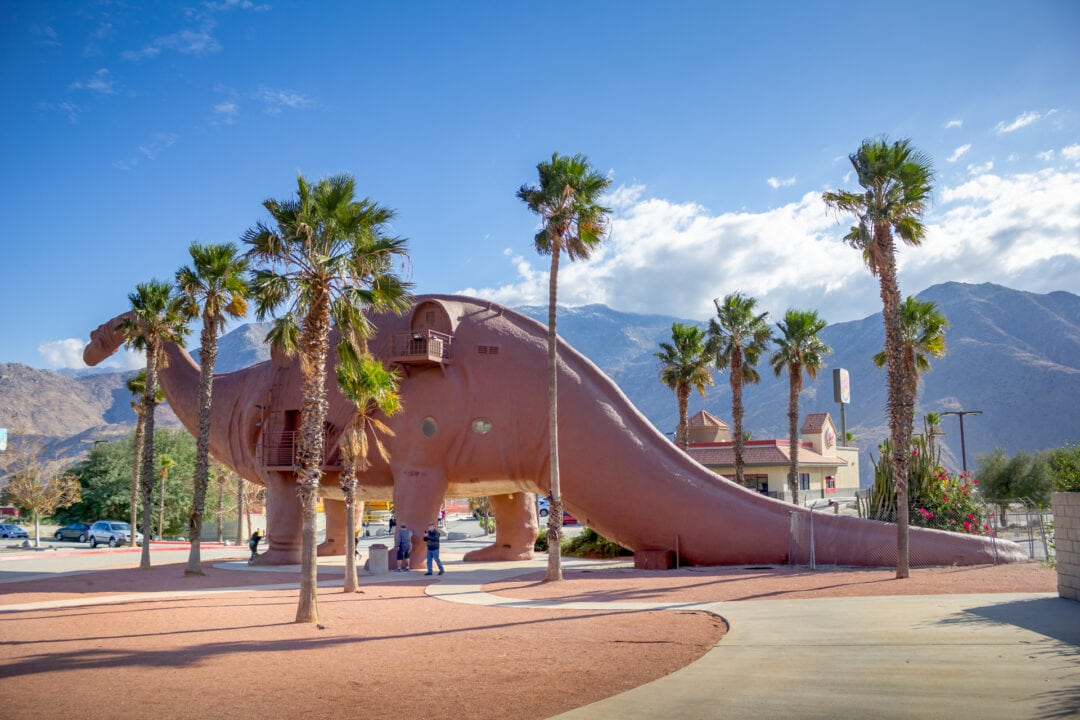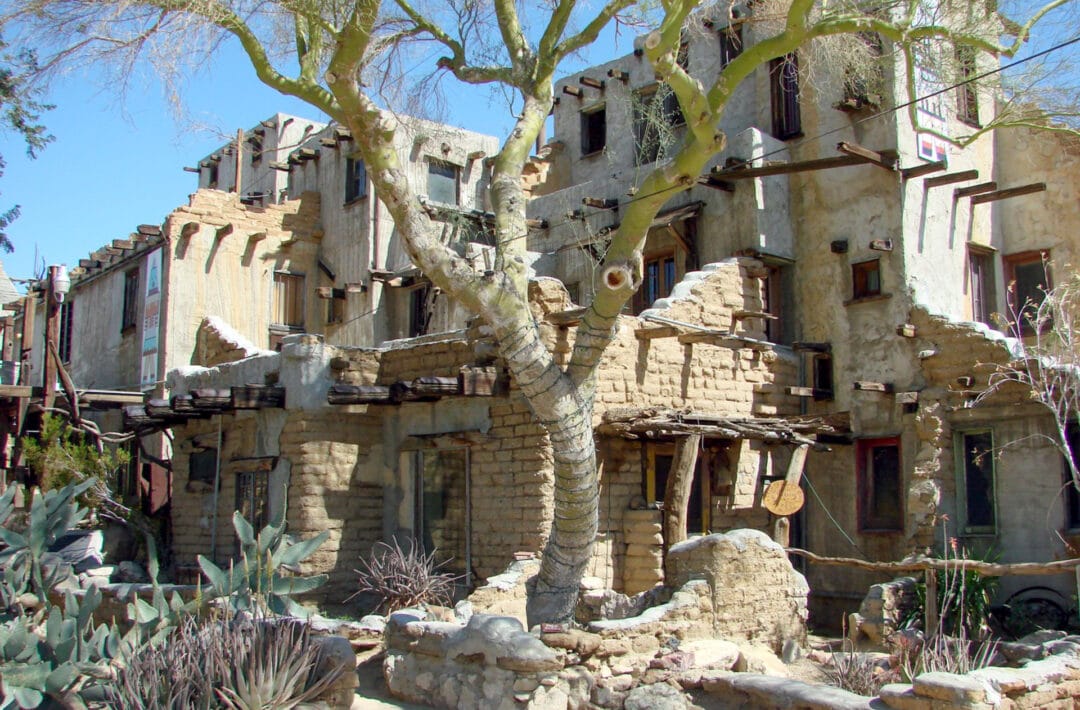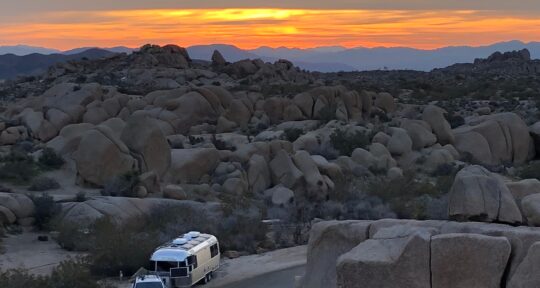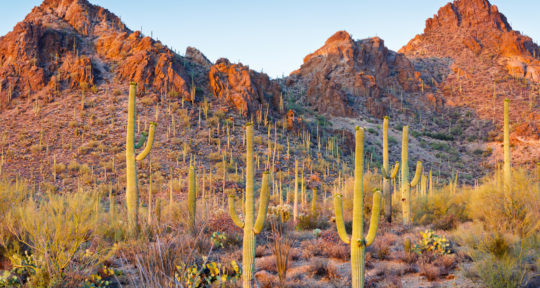The Coachella Valley Music and Arts Festival takes place in Indio, California, over two weekends in April. The festival boasts some of the biggest names in music today, and tickets—which range from about $400 to several thousand—are famously difficult to come by.
In 2023, the festival dates are April 14 to 16 and April 21 to 23, and both weekends typically sell out quickly. But whether you’ve managed to snag a coveted ticket to the event or not, the Coachella Valley is well worth a visit. Desert resort cities like Palm Springs and Palm Desert are packed with mid-century modern design and art, and on the outskirts of the area you’ll find quirky roadside attractions and scenic desert landscapes.
Here are eight stops on a road trip through the Coachella Valley and its surrounding areas.

1. Salvation Mountain
No trip to this part of the California desert is complete without a detour to Salvation Mountain. Located east of the Salton Sea, about an hour and a half south of Palm Springs, this trippy art installation was created by local eccentric Leonard Knight. The “mountain” and its many nooks and crannies are made of adobe bricks and covered in thousands of gallons of paint—much of it donated by visitors—which spell out Bible verses and other religious language. Knight passed away in 2014, but his psychedelic wonderland lives on thanks to the efforts of volunteers.

2. Salton Sea State Recreation Area
The Salton Sea State Recreation Area offers five campgrounds and day-use areas for activities such as boating and hiking. If the eerie 340-square-mile lake seems misplaced in the Colorado Desert, where summer temperatures regularly reach well over 100 degrees Fahrenheit, it’s because it is. Created by an engineering mistake in the early 1900s, it has no outlet. In the 1950s and ‘60s, the Salton Sea played host to a thriving resort community, featuring beaches, yacht clubs, and water activities. But in the last several decades, surrounding structures have been damaged by heavy storms, fish and bird populations have declined due to high salinity levels, and toxic dust from the drying lake is affecting nearby residents. Today, mostly-abandoned squatter communities share the shores with stunning pastel-colored sunsets and offbeat art installations.

3. Sunnylands
Sunnylands was built as the winter home of Walter and Leonore Annenberg, philanthropists and U.S. Ambassadors to the U.K. during Richard Nixon’s presidency. Sometimes referred to as the Camp David of the West, it’s hosted presidents and other celebrities since the 1960s. Today, the 200-acre estate, located in Rancho Mirage, is run by a nonprofit foundation and open to the public. On a 15-acre lot adjacent to the house is the Sunnylands Center & Gardens visitor center. The center’s artful botanical garden is home to more than 70 species of desert plants, including agave, aloe, and cacti, and strolling through the grounds is a serene experience that feels far removed from the surrounding city.

4. Palms to Pines Scenic Byway
If you’re driving into the Coachella Valley from the south, there’s no better way to enter than via California Highway 74, also known as the Palms to Pines Scenic Byway. The highway also makes for a great day trip into the mountains to escape the heat of the desert floor. Coming from Palm Desert, start at the Santa Rosa and San Jacinto Mountains National Monument visitor center and make your way up the mountain via a series of switchbacks. Stop at the Coachella Valley Vista Point for breathtaking views of the desert cities below. As you continue south, the desert scenery gives way to pine trees and small mountain towns. Grab lunch at Paradise Valley Cafe, a favorite stop for motorcyclists, or continue to Idyllwild for more food and retail options.

5. Moorten Botanical Garden
Moorten Botanical Garden in Palm Springs is small but mighty. The second-generation, family-owned arboretum opened in 1938 and features 3,000 desert plants from all over the world. It also displays a collection of crystals, fossils, and rocks. Clark Moorten—who took over the garden from his parents, Chester “Cactus Slim” and Patricia Moorten—is likely to be around and greet you during your visit. Stroll through the outdoor exhibits and the cactarium greenhouse before ending up at a nursery where you can take home your own cactus.

6. Cabazon Dinosaurs
For a quick photo op with Dinny the Dinosaur and Mr. Rex, stop at the Cabazon Dinosaurs, located just off of Interstate 10. The two giant dinosaur sculptures—a Brontosaurus and a Tyrannosaurus rex—are most famous for their appearance in the 1985 comedy classic Pee-wee’s Big Adventure. Buy a souvenir in the gift shop located inside of Dinny or visit the dinosaur park for even more dinos. If you show up during a holiday or other celebratory event, expect to see the dinosaurs painted accordingly—think beachwear for summer, pink for Valentine’s Day, and a full Santa suit for Christmas.

7. Cabot’s Pueblo Museum
Cabot Yerxa arrived in Desert Hot Springs in 1913 and started building his impressive residence using reclaimed and found materials. The resulting pueblo—today known as Cabot’s Pueblo Museum—is a four-story, 5,000-square-foot building that features 150 windows and 65 doors. The Hopi-inspired pueblo’s 35 rooms are packed with art and artifacts, souvenirs from Cabot’s travels, and displays on his many decades as a Native American rights activist. The museum hosts cultural events, an annual fundraising gala, and a Trading Post where visitors can purchase art and souvenirs.

8. Joshua Tree National Park
An hour north of Palm Springs is the town of Joshua Tree, home to vintage shops, vegan cafes, and a national park. At 1,240 square miles, Joshua Tree National Park is about the size of Rhode Island. It straddles two distinct desert ecosystems, the Mojave and the Colorado, which becomes obvious when driving the length of the park from north to south.
The upper Mojave portion is home to the park’s namesake Joshua trees and large boulder formations, and is popular with rock climbers, hikers, and campers. The lower Colorado Desert part of the park features cactus gardens, ocotillos, and plenty of unpaved roads for those with four-wheel drive vehicles to explore. There are no restaurants or gas stations within the park, so plan accordingly.





